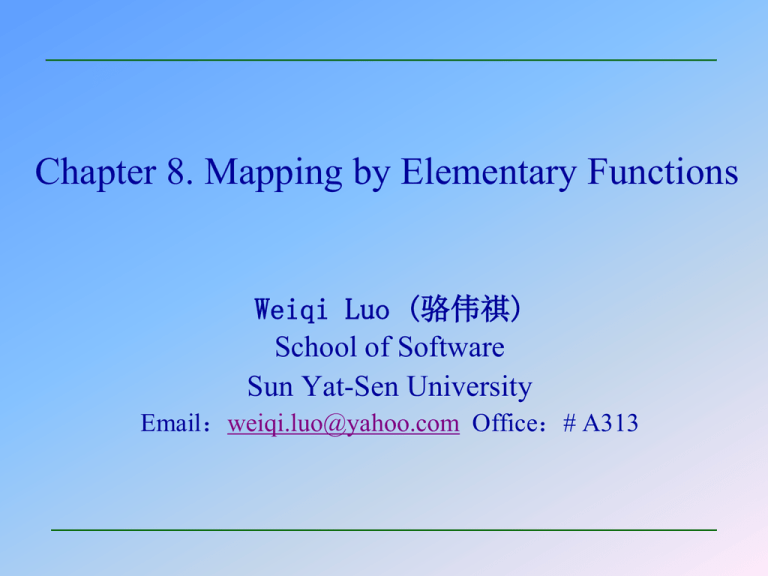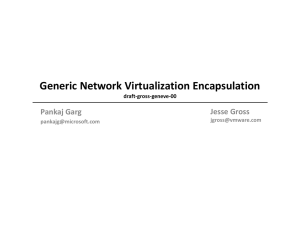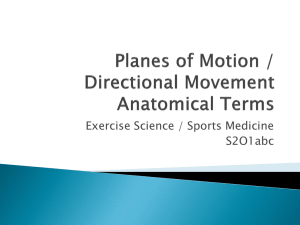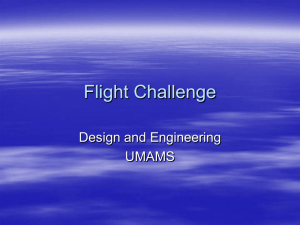Chap. 8 - Sun Yat
advertisement

Chapter 8. Mapping by Elementary Functions Weiqi Luo (骆伟祺) School of Software Sun Yat-Sen University Email:weiqi.luo@yahoo.com Office:# A313 Chapter 8: Mapping by Elementary Functions Linear Transformations The Transformation w=1/z Mapping by 1/z Linear Fractional Transformations Mapping of the Upper Half Plane 2 School of Software 90. Linear Transformations The Mapping w Az where A is a nonzero complex constant and z≠0. We write A and z in exponential form: A aei , z rei Then w (ar )ei ( ) Expands or contracts the radius vector representing z by the factor a and rotates it through the angle α about the origin. The image of a given region is geometrically similar to that region. 3 School of Software 90. Linear Transformations The Mapping w zB where B is any complex constant, is a translation by means of the vector representing B. That is, if w u iv, z x iy, B b1 ib2 Then the image of any point (x,y) in the z plane is the point in the w plane (u, v) ( x b1 , y b2 ) The image of a given region is geometrically congruent to that region. 4 School of Software 90. Linear Transformations The General (non-constant) Linear Transformation w Az B,( A 0) is a composition of the transformations Z Az,( A 0) and wZ B when z≠0, it is evidently an expansion or contraction (scaling) and a rotation, followed by a translation. 5 School of Software 90. Linear Transformations Example The mapping w (1 i) z 2 transforms the rectangular region in the z=(z, y) plane of the figure into the rectangular region in the w=(u,v) plane there. This is seen by expressing it as a composition of the transformations Z (1 i ) z 2r exp[i ( )] 4 &w Z 2 ( X 2, Y ) 6 School of Software 90. Linear Transformations Example (Cont’) Scaling and Rotation (x,y)-plane (X,Y)-plane 7 Translation (u,v)-plane School of Software 90. Homework pp. 313 Ex. 2, Ex. 6 8 School of Software 91. The Transformation w=1/z The Equation 1 w z establishes a one to one correspondence between the nonzero points of the z and the w planes. 2 Since zz | z |, the mapping can be described by means of the successive transformations z Z 2 ,w Z |z| To make the transformation continuous on the extended plane, we let w(0) , w() 0 9 School of Software 92. Mapping by w=1/z The Mapping 1 z z w 2 z zz | z | reveals that u x y , v x2 y 2 x2 y 2 Similarly, we have that 1 w w z w ww | w |2 u v x 2 2,y 2 2 u v u v Based on these relations between coordinates, the mapping w=1/z transforms circles and lines into circles and lines 10 School of Software 92. Mapping by w=1/z Consider the Equation A( x y ) Bx Cy D 0 2 2 represents an arbitrary circle or line (B2+C2>4AD) Circle: Line: B 2 C 2 B 2 C 2 4 AD 2 (x ) (y ) ( ) ,( A 0) 2A 2A 2A Bx Cy D 0,( A 0) Note: Line can be regarded as a special circle with a infinite radius. 11 School of Software 92. Mapping by w=1/z The Mapping by w=1/z If x and y satisfy A( x2 y2 ) Bx Cy D 0 (a circle or line in (x,y)-plane ) u v then after the mapping by w=1/z, i.e.x 2 2 , y 2 2 u v u v we get that D(u v ) Bu Cv A 0 2 2 (also a circle or line in (u,v)-plane ) 12 School of Software 92. Mapping by w=1/z Four Cases Case #1: A circle (A ≠ 0) not passing through the origin (D ≠ 0) in the z plane is transformed into a circle not passing through the origin in the w plane; Case #2: A circle (A ≠ 0) through the origin (D = 0) in the z plane is transformed into a line that does not pass through the origin in the w plane; Case #3: A line (A = 0) not passing through the origin (D ≠ 0) in the z plane is transformed into a circle through the origin in the w plane; Case #4: A line (A = 0) through the origin (D = 0) in the z plane is transformed into a line through the origin in the w plane. 13 School of Software 92. Mapping by w=1/z Example 1 A vertical line x=c1 (c1≠0) is transformed by w=1/z into the circle –c1(u2+v2)+u=0, or (u 1 2 2 1 ) v ( )2 2c1 2c1 Example 2 A horizontal line y=c2 (c2≠0) is transformed by w=1/z into the circle 1 2 1 2 u (v ) ( ) 2c2 2c2 2 14 School of Software 92. Mapping by w=1/z Illustrations 15 School of Software 92. Mapping by w=1/z Example 3 When w=1/z, the half plane x≥c1 (c1>0) is mapped onto the disk 1 2 2 1 2 (u 2c1 ) v ( 2c1 ) For any line x=c (c ≥c1) is transformed into the circle 1 2 2 1 2 (u ) v ( ) 2c 2c Furthermore, as c increases through all values greater than c1, the lines x = c move to the right and the image circles shrink in size. Since the lines x = c pass through all points in the half plane x ≥ c1 and the circles pass through all points in the disk. 16 School of Software 92. Mapping by w=1/z Illustrations 17 School of Software 92. Homework pp. 318 Ex. 5, Ex. 8, Ex. 12 18 School of Software 93. Linear Fractional Transformations The Transformation az b w , (ad bc 0) cz d where a, b, c, and d are complex constants, is called a linear fractional (Möbius) transformation. We write the transformation in the following form Azw Bz Cw D 0,( AD-BC 0) this form is linear in z and linear w, another name for a linear fractional transformation is bilinear transformation. Note: If ad-bc=0, the bilinear transform becomes a constant function. dw ad bc 0 2 dz (cz d ) 19 School of Software 93. Linear Fractional Transformations az b w , (ad bc 0) cz d When c=0 When c≠0 w az b a b z , (ad 0) d d d a bc ad 1 w , (ad bc 0) c c cz d which includes three basic mappings 1 a bc ad Z cz d ,W , w W Z c c It thus follows that, regardless of whether c is zero or not, any linear fractional transformation transforms circles and lines into circles and lines. 20 School of Software 93. Linear Fractional Transformations az b T ( z) , (ad bc 0) cz d To make T continuous on the extended z plane, we let T () ,(c 0) a d T () & T ( ) , (c 0) c c There is an inverse transformation (one to one mapping) T-1 dw b T ( w) , (ad bc 0) cw a d 1 a 1 1 T ( ) & T ( ) , (c 0) T () ,(c 0) c c 1 21 School of Software 93. Linear Fractional Transformations Example 1 Let us find the special case of linear fractional transformation that maps the points z1 = −1, z2 = 0, and z3 = 1 onto the points w1 = −i, w2 = 1, and w3 = i. T (0) 1 T (1) i, T (1) i T ( z) ad bc 0 b(a c) 0 b 0 a ib ic ib a b ic ib a b c ib bd ibz b b(iz 1) , (b 0) ibz b b(iz 1) 22 T ( z) iz 1 i z iz 1 i z School of Software 93. Linear Fractional Transformations Example 2 Suppose that the points z1 = 1, z2 = 0, and z3 = −1 are to be mapped onto w1 = i, w2 =∞, and w3 = 1. T (0) T (1) i T (1) 1 c 0, d 0 az b T ( z) , (bc 0) cz ic a+b, c a b T ( z) 2a (1 i)c, 2b (i 1)c (i 1) z (i 1) 2z 23 School of Software 94. An Implicit Form The Equation ( w w1 )( w2 w3 ) ( z z1 )( z2 z3 ) ( w w3 )( w2 w1 ) ( z z3 )( z2 z1 ) defines (implicitly) a linear fractional transformation that maps distinct points z1, z2, and z3 in the finite z plane onto distinct points w1, w2, and w3, respectively, in the finite w plane. Verify this Equation Why three rather than four distinct points? 24 School of Software 94. An Implicit Form Example 1 The transformation found in Example 1, Sec. 93, required that z1 = −1, z2 = 0, z3 =1 and w1 = −i, w2 = 1, w3 = i. Using the implicit form to write ( w i)(1 i) ( z 1)(0 1) ( w i)(1 i) ( z 1)(0 1) Then solving for w in terms of z, we have iz w iz 25 School of Software 94. An Implicit Form For the point at infinity For instance, z1=∞, 1 )( z2 z3 ) ( z z1 )( z2 z3 ) ( z1 z 1)( z2 z3 ) z2 z3 z1 z1 lim lim z 0 z 0 1 ( z z3 )( z2 z1 ) 1 ( z z )( z ) z1 1 ( z z3 )( z1 z2 1) z z3 3 2 z1 (z Then the desired modification of the implicit form becomes ( w w1 )( w2 w3 ) z2 z3 ( w w3 )( w2 w1 ) z z3 The same formal approach applies when any of the other prescribed points is ∞ 26 School of Software 94. An Implicit Form Example 2 In Example 2, Sec. 93, the prescribed points were z1 = 1, z2 = 0, z3 = −1 and w1 = i, w2 =∞, w3 = 1. In this case, we use the modification w w1 ( z z1 )( z2 z3 ) w w3 ( z z3 )( z2 z1 ) of the implicit form, which tells us that w i ( z 1)(0 1) w 1 ( z 1)(0 1) Solving here for w, we have the transformation obtained earlier. (i 1) z (i 1) w 2z 27 School of Software 94. Homework pp. 324 Ex. 1, Ex. 4, Ex. 6 28 School of Software 95. Mappings of The Upper Half Plane Mappings of the Upper Half Plane We try to determine all linear fractional transformations that map the upper plane (Imz>0) onto the open disk |w|<1 and the boundary Imz=0 of the half plane onto the boundary |w|=1 of the disk y az b w , (ad bc 0) cz d v 1 x u 29 School of Software 95. Mappings of The Upper Half Plane Imz=0 are transformed into circle |w|=1 az b w , (ad bc 0) cz d when points z=0, z=∞ we get that | b || d | 0 Rewrite | a || c | 0 az b a z (b / a) w ( ) cz d c z (d / c) b d | || | 0 a c z z0 a b d i we ( ), (e , z0 , z1 ,| z1 || z0 | 0) z z1 c a c i where α is a real constant, and z0 and z1 are nonzero complex constants. 30 School of Software 95. Mappings of The Upper Half Plane z z0 we ( ), (| z1 || z0 | 0) z z1 i when points z=1, we get that |1 z0 ||1 z1 | (1 z0 )(1 z0 ) (1 z1 )(1 z1 ) z1 z1 z0 z0 ,(| z1 || z0 |) z1 z0orz1 z0 If z1=z0, then w ei is a constant function Therefore, z1 z0 z z0 we ( ), (Im z0 0) z z0 i Finally, we obtain the mapping 31 School of Software 95. Mappings of The Upper Half Plane Mappings of The Upper Half Plane z z0 we ( ), (Im z0 0) z z0 i w 32 School of Software 95. Mappings of The Upper Half Plane Example 1 The transform iz w iz in Examples 1 in Sections. 93 and 94 can be written z i we ( ) z i i 33 School of Software 95. Mappings of The Upper Half Plane Example 2 By writing z = x + iy and w = u + iv, we can readily show that the transformation z 1 w z 1 maps the half plane y > 0 onto the half plane v > 0 and the x axis onto the u axis. Firstly, when the number z is real, so is the number w. Since the image of the real axis y=0 is either a circle or a line, it must be the real axis v=0. 34 School of Software 95. Mappings of The Upper Half Plane Example 2 (Cont’) Furthermore, for any point w in the finite w plane, ( z 1)( z 1) 2y v Im w Im ,( z 1) 2 ( z 1)( z 1) | z 1| which means that y and v have the same sign, and points above the x axis correspond to points above the u axis. Finally, since point on x axis correspond to points on the u axis and since a linear fractional transformation is a one to one mapping of the extended plane onto the extended plane, the stated mapping property of the given transformation is established. 35 School of Software 95. Mappings of The Upper Half Plane Example 3 The transformation z 1 w Log z 1 where the principal branch of the logarithmic function is used, is a composition of the function z 1 Z & w LogZ z 1 According to Example 2, Z=(z-1)/(z+1) maps the upper half plane y>0 onto the upper half plane Y>0, where z=x+iy, Z=X+iY; 36 School of Software 95. Mappings of The Upper Half Plane Example 3 (Cont’) Z Rei ,( R 0,0 ) w Log (Rei ) ln R i R 0, 0 37 School of Software 95. Homework pp. 329 Ex. 1, Ex. 2 38 School of Software






